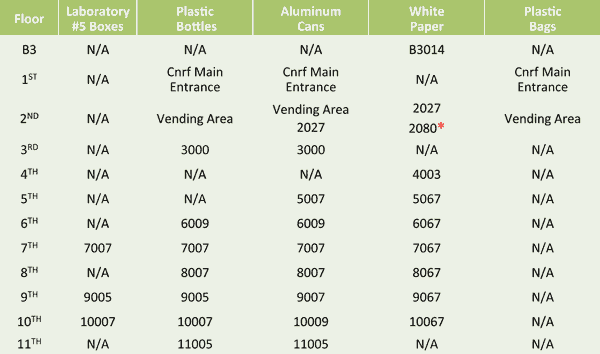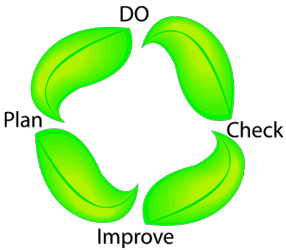CNRC Green Efforts
- Environmental Management Systems
- Current CNRC EMS Programs
- Contact Info For EMS team
- EMS Quick Facts
- Green Sign-up
Environmental Management Systems
The CNRC "Green" effort utilizes an Environmental Management System to achieve its goals of environmental responsibilities.
EMS is a framework that allows an organization to consistently address and improve the effects its operations may have on the environment. At its essence, an EMS is a simple continual improvement loop in which a facility (1) identifies its environmental aspects and impacts, (2) selects the most significant of those aspects/impacts as targets for improvement, (3) develops improvement goals and procedures for the significant aspect/impacts, and (4) reevaluates its accomplishments yearly in November, returning to Step (1) to continue the loop.
Click on the graphic to see the CNRC Policy Statement.
Recycling Bin Locations

* Color Paper, Newspaper
Current CNRC EMS Programs
- Paper
- Cardboard
- Toner Cartridges
- Batteries
- Aluminum Cans
- Plastic Recycling
- Space Heaters
- Hybrid Vehicle
Paper
The CNRC began its paper recycling program in 2006 and recycled approximately 1,900 lbs of paper that year. Annually, the CNRC recycles an average of 22,100 lbs of both white and color paper and has drastically reduced its paper waste so much so that the building dumpsters are emptied less frequently.
- Collection Locations:
- 2nd Floor
- White Paper – Break Room RM 2027
- Color/Glossy Paper – Mail Room RM 2080
- 4th – 11th floor bins are for white paper only and are located either near the copiers or the freight elevator.
- 2nd Floor
- CNRC Safely Recycling White Paper SOP.pdf
Cardboard
The CNRC tested a cardboard recycling program through Baylor College of Medicine in 2008. In 2009, the cardboard recycling is fully implemented and continued for the CNRC, recycling approximately 80 lbs per week.
- Collection Locations:
- All cardboard is collected adjacent to the freight elevators on each floor
- CNRC Safely Recycling Cardboard Containers SOP.pdf
Toner Cartridge
Over 13 printer cartridges are disposed of in an American trash can every second, totaling an estimated 375 million each year. These cartridges can take almost a thousand years to decompose if left to breakdown in a landfill. Why not recycle yours and contribute to the materials used to produce remanufactured cartridges?
Many cartridge companies now re-use almost 100 percent of old cartridges to produce new ones, adding only new ink. It takes about 80 percent less energy to remanufacture the cartridge plastic than to produce it from new materials. Also, remanufactured laser cartridges use about half the amount of oil needed to make new cartridges. The process also saves over 38,000 tons of plastic and metal from landfills.
-information collected from http://earth911.com/
In 2006, the CNRC began a program to collect and recycle used toner cartridges. The program has grown from 53 cartridges collected that first year to approximately 110 collected in 2008.
- Collection Location:
- Please bring all empty toner cartridges to Kathy Jenkins in room 2060
- CNRC Safely Recycling Printer Cartridges SOP.pdf
Batteries
According to the EPA, batteries, such as dry cell batteries (like AAA and D) and car batteries, are considered hazardous waste and require special handling to dispose of them. Fortunately, the CNRC has created a program to recycle dry cell batteries (AAA, AA, C &D).
- Collection Location:
- Please bring all used batteries to Kathy Jenkins in room 2060
- CNRC Safely Recycling Batteries SOP.pdf
Aluminum Cans
- The aluminum can is the most valuable container to recycle and is the most recycled consumer product in the U.S. today.
- Each year, the aluminum industry pays out over $800 million dollars for empty aluminum cans — that’s a lot of money that can go to organizations like Habitat for Humanity, the Boy or Girl Scouts of America or even a local school. Money earned from recycling cans helps people help themselves and their communities. Recycling helps build new homes, pays for a group trip, supports a project or buys a lunch!
- Today it is cheaper, faster and more energy-efficient to recycle aluminum than ever before. The aluminum can is 100 percent recyclable and can be recycled indefinitely. The can remains the most recyclable of all materials.
- Other types of aluminum, such as siding, gutters, car components, storm window frames and lawn furniture can also be recycled.
- Aluminum has a high market value and continues to provide an economic incentive to recycle. When aluminum cans are recycled curbside, they help pay for community services.
-Information collected from http://earth911.com
To that end, the CNRC has had an aluminum recycling program in place for years which relies on employee volunteers to transport the aluminum cans to a recycle center.
- Collection Location:
- 2nd Floor Collection Bin in the break room
Plastic Recycling
Unlike landfills (which simply stockpile trash) recycling removes waste completely, then turns it back to useful products. Recycling saves money, and in turn reduces the amount of trash going to the landfills. The CNRC has two separate recycling programs for plastic.
Plastic Bottles
It is estimated that 2.5 million water bottles are used every hour. Did you know that enough plastic bottles are thrown away each year to circle the earth four times? We have seen manufactures attempt to reduce plastic use as well in some cases. Since 1977, the 2-liter plastic soft drink bottle has gone from weighing 68 grams to just 51 grams today, representing a 25% reduction per bottle. The gallon plastic milk jug has undergone an even greater reduction, weighing 30% less than what it did 20 years ago.
The CNRC is doing their part by recycling plastic bottles. Plastic bottle collection sites are found at the following locations:
- 1st Floor by freight elevator
- 2nd Floor Vending Machine Lobby
- Rm 3000
- Rm 6009
- Rm7007
- Rm 8007
- Rm 9005
- Rm10007
- Rm1105
Plastic Bags
By using plastic in packaging, American product manufacturers save enough energy each year to power a city of 1 million homes for three and a half years. For every seven trucks needed to deliver paper grocery bags to a store, only one truck is needed the carry the same number of plastic grocery bags.
To that end, the CNRC has a plastic bag recycling program. Collection locations are found at:
- 1st Floor by freight elevator
- 2nd Floor Vending Machine Lobby
Space Heater
Baylor College of Medicine has stated that space heaters at the college cost about $2.00 a day to operate. They recommend that employees unplug their space heaters to save money. The CNRC has taken it a step further by totally eliminating space heaters in the CNRC as an EMS goal. Space heaters cause these concerns:
- They are a fire hazard even if they have built-in fire protection.
- They are usually not energy efficient – Using a space heater for a month can cost as much as $214 at the rates that the CNRC currently pays.
- They can damage computers and electronic equipment if they are on the same circuit (they can be on the same circuit even though they aren’t plugged into the same receptacle).
- If a space heater is near the room’s temperature sensor, the overall effect will be counterproductive with the air conditioning and the space heater working against each other.
The CNRC has offered these suggestions to keep warm:
- Choosing warm shoes or boots can make a big difference to the temperature of your feet and consequently the rest of your body.
- If you are wearing shoes with socks, choose thicker socks.
- Leave a sweater or light jacket at work for times that you are cold.
- Drink a cup of coffee, hot tea, or hot chocolate
- Contact Jackie Walker (713-798-7015) or Bill Ogden (713-798-7032) if your area is cold so that the situation can be investigated. Maintenance personnel are usually successful at achieving an acceptable comfort level for multiple occupants when these problems are reported.
Hybrid Vehicle
By now, we all know that something needs to be done to protect our environment, not just for future generations, but also for sustainability within our own lifetimes. The burning of fossil fuels needs to be minimized - and electric, hybrid, and E-85 vehicles are helping to do that. The hybrid vehicle typically achieves greater fuel economy and lower emissions than conventional internal combustion engine vehicles (ICEVs), resulting in fewer emissions being generated. Hybrid vehicle use is particularly efficient for city traffic where there are frequent stops, coasting and idling periods. In addition noise emissions are reduced, particularly at idling and low operating speeds, in comparison to conventional engine vehicles.
The CNRC acquired a USDA Hybrid Ford Escape in 2016 which is available for center use by CNRC authorized drivers. The vehicle has a huge set of batteries in the rear where a spare tire would typically be located. Batteries are charged by the driver braking the vehicle when coming to a stop. Once the batteries are charged to a certain point and the vehicle is at a stop or coming to stop, the driver may notice the vehicle?s engine stops running. (the driver will continue to see a green arrow illuminated on the dash). The car will have automatically switched to electric battery and everything will still be operational. The driver will be operating via the battery up to 40 mph in which the engine will start again. The operation is seamless.
Contact Info For EMS team
| Paul Nakata | 713-798-7013 | pnakata@bcm.edu |
| Bill Ogden | 713-798-7032 | bogden@bcm.edu |
| Jennifer Coon | 713-798-7143 | Jennifer.Coon@bcm.edu |
| Perry Rainosek | 713-798-7034 | rainosek@bcm.edu |
| To request recycle bin pick up: cnrcdock@bcm.edu | ||
EMS Quick Facts
- CNRC EMS brochure.pdf
- How to Keep it Green, Energy Efficient, and Safe
- Energy Star Lighting Brochure.pdf
- Suggestions from EMS staff that can be used for work or at home.


